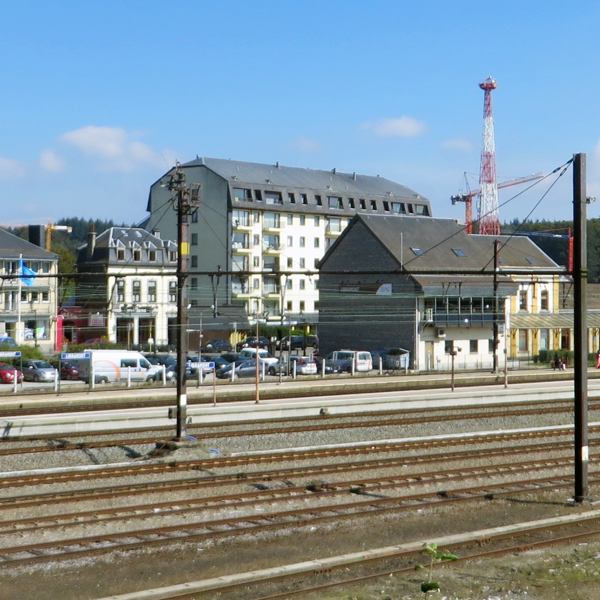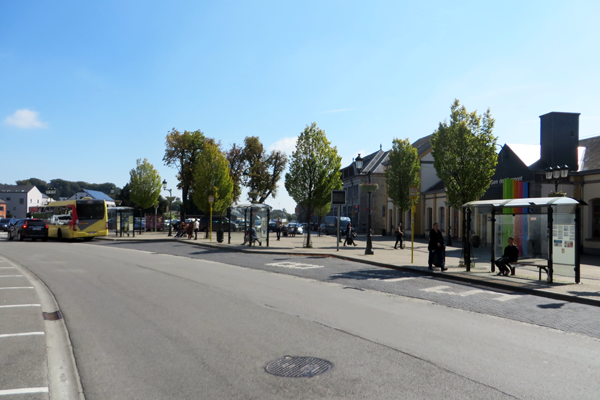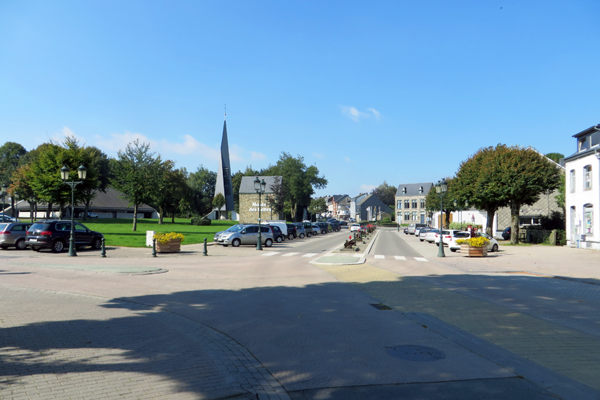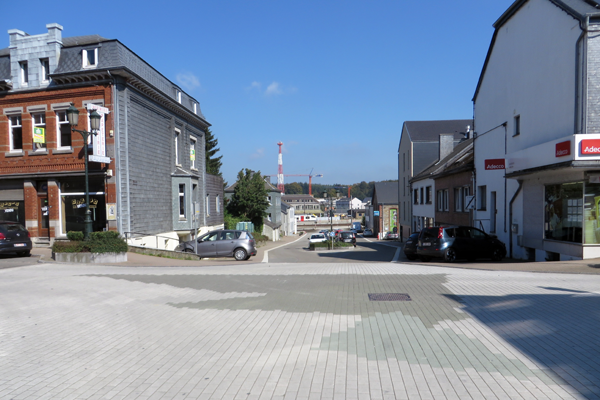Libramont
The Synthetic Site Folder and Site Brief are available for free.
Please register and login to access the Complete Site Folder.
- Synthetic site folder EN | FR
- Site on Google Maps
- Back to map
Data

E13-BE-Libramont-Cover
Category Town planning and architecture
Location Libramont-Chevigny, Train station quarter
Population 10,947 inhab.
Strategic site c. 32 ha - Project site 10 ha
Site proposed by Municipality of Libramont and Belgian Rail (SNCB)
Owner(s) of the site mostly SNCB, the Municipality and private individuals
Commision after competition Town planning study, architectural design of public spaces and certain buildings
Team representative town planner – landscape architect – architect
More Information
How can the site contribute to the adaptable city?
In the heart of the province of Luxembourg, the municipality of Libramont-Chevigny is situated on the high plateau of the Belgian Ardennes. A simple hamlet up to the 19th century, the village of Libramont would grow after the arrival of the railway. The focal point of a rural region, Libramont boasts several public facilities: schools, hospital, cultural centre, exhibition centre, convention centre. Its development has in recent decades shifted to the Recogne commercial hub, situated 1.5 km from the centre. Today, a new development dynamism is gradually taking shape in the train station quarter. The upcoming release of all rail operation for part of the land in the South West of the railway lines constitutes a winning asset for the development of the centre of Libramont. The Municipality accordingly wants a master plan covering the entire area.
City strategy
Thanks to its “railway boom,” Libramont developed on either side of the railway line. The quarter of the centre to the South-West of the railway lines comprises many public buildings around the Place Communale. The North-south bank of the railway plays host to the intermodal hub and public facilities. The cut-off formed by the railway lines is crossed only at two points. The municipality wants to restructure two banks on either side of the train station and to link them so as to create the Heart of Libramont. This response to the needs to do with demographics, commerce and business facilities should boost the appeal of the train station and develop the administrative role of Libramont. Three lines of action have been determined: improve the functionality of the train station to turn it into a 21st century station, give new impetus to the forecourt of the train station by making it denser and connecting the quarters on either side of the railway line.
Site definition
The site comprises two parts separated by the railway. 1° the forecourt of the train station. The train station is used daily by nearly 3,000 passengers. The traffic flows – kiss and ride, bus stop, access to tracks – are no longer functional. The mobility around the train station must be reviewed giving preference to intermodal transport and non-motorised modes. Parking of cars in front of the train station is saturated and restructuring of the offer in parking for train passengers on either side of the tracks should reduce traffic on the crossing points of the tracks. 2° The Triangle in the South-West of the tracks. The SNCB will free all rail operation on this part of the site, particularly the “turnaround triangle”. The development of this site should make it possible to improve the reception functionalities of passengers – parking facilities, access to tracks, etc. and to connect the Place Communale with the forecourt of the train station.
Future of the site in relation to the site family and to Adaptability
The Heart of Libramont comprises 3 steps or “sub-projects;” 1° The connection between the Rue de l’Ancienne and the forecourt of the Train Station and its endings. For the link reserved for non-motorised modes (for pedestrians and bicycles), the Municipality wishes to build an underpass and not a footbridge, given the climatic constraints. This option must be included as a minimum, The underpass corridor ends in the South, with a new car park for passengers and a support building, and in the North on the foreground of the train station, which is to be redeveloped; 2° The quarter of the Train Station with 19,500 m² of dwellings, offices, shops and local services, and a parking facility for 500 places; 3° The Triangle with shared roads connecting the Rue de l’Ancienne Gare with the Place Communale by distributing a property development of 73,000 m² of dwellings, offices, shops and local services and a car park with 1000 places. The continuity of the entire functionality of the site – particularly the intermodal use of train/bus/car parks—must be ensured without fail, during the different development stages, whilst preserving access to the technical premises of the SNCB. Given the scope of the means and resources required for the development of the site, each of the three steps must be the subject of flexible and open-ended programming. The construction of the parking areas must be staggered and modular: the parking facilities for passengers are to be scheduled in an initial step, and the parking facilities for residents apace with the completion of the buildings. The space for offices and dwellings must be reversible to adapt to the development of needs not yet defined with precision. Finally, the planning must include a release of the land according to the choice of construction of the buildings and the development of public spaces.




Questions on the site
Where are the premises to maintain that are currently used by the SNCB?
The premises currently used by SNCB –signal box– to maintain without change, as referred to in Part 3-1 on page 10 of the site presentation document is the building located South-West of the project site along the rue des Alliés. This building located on the study site -and not on the project site- should undergo no intervention; indeed, as shown on picture Libramont-BE-SS-P6, this building was recently completed.
Can we consider the building located directly South-East from the station, along the railway lines, as it is –29 homes and businesses of 1,600 sqm– or can we imagine a different future for this building by reincorporating the program somewhere else on the site?
This building (mentioned at point 3-1 page 10 of the site presentation document) was sold by SNCB to a private developer, who plans to make 29 apartments and 1,600 sqm of commercial areas. This area is clearly defined on illustration 8. It is therefore a constraint of the program and no other hypothesis can not be considered for this building.
What is the exact limitation of the project area (yellow line) at the junction between the "triangle reversal" and the "corridor under the tracks"?
Europan is a competition of ideas to select a team to further develop a comprehensive development project for the proposed site. The information on site presentation file is a general data for E13 participants to propose a site organization and phasing of interventions.
The limitations of the project areas to be considered by participants –a.o. information on areas reserved for rail traffic– are sufficiently accurate for the stage of the competition of ideas. Those will be later defined on basis of the information provided by the developer for the further development of a detailed project.
As stated in paragraph 3-2 of the program of the project site, candidates are asked to propose a link between both sides of the railway, from the forecourt of the station to the end of the street of the Old Station. Further specification is not required at this stage.
Where can I find the original illustrations of the document "Heart of Libramont - Presentation of the site"?
Some documents were added on the FTP, please consult them for further info.
What is the exact limitation of the zone defining “the whole South/West rail exploitation"?
Europan is a competition of ideas to select a team to further develop a comprehensive development project for the proposed site. The information on site presentation file is a general data for E13 participants to propose a site organization and phasing of interventions.
The limitations of the project areas to be considered by participants –a.o. information on areas reserved for rail traffic– are sufficiently accurate for the stage of the competition of ideas. Those will be later defined on basis of the information provided by the developer for the further development of a detailed project.
Are rails parallel to the station part of the study area?
Europan is a competition of ideas to select a team to further develop a comprehensive development project for the proposed site. The information on site presentation file is a general data for E13 participants to propose a site organization and phasing of interventions.
The limitations of the project areas to be considered by participants –a.o. information on areas reserved for rail traffic– are sufficiently accurate for the stage of the competition of ideas. Those will be later defined on basis of the information provided by the developer for the further development of a detailed project.
What about the area between the freight railtracks and the rails belonging to the station?
Europan is a competition of ideas to select a team to further develop a comprehensive development project for the proposed site. The information on site presentation file is a general data for E13 participants to propose a site organization and phasing of interventions.
The limitations of the project areas to be considered by participants –a.o. information on areas reserved for rail traffic– are sufficiently accurate for the stage of the competition of ideas. Those will be later defined on basis of the information provided by the developer for the further development of a detailed project.
Is required to maintain the existing station building ? Could you please upload more detailed drawings of buildings to maintain ?
The station should be maintained in its current state, without any change. This is wy no station map has benn provided.
As indicated on figure 8, the building directly next to the station on the project site is intended for a private project of 29 apartements. This project is currently under study and therefore it is to be considered without possibility of change.
The technical SNCB building on the study site, southwest of the station, should be maintained in its present condition.
The route of the underpass (village street) is bonded ? It's possible to change his position ?
The underpass road of Village Street is not saturated and canno't be modified
In the lot with private intervention there is in project a pubblic link between Grand rue and "the triangle de retournement"?
As shown in the figure 11 and in part 3 detailing the program of the project site, two connections are provided between the "triangle de retournement" and "Grand rue". These are the current street of the old station and a new connection, opening up in front of the town square, at the tip of the "triangle de retournement". No other connection is planned.
On all the study and the project areas there are a lot of slopes not so clear in the dxf drawing. Could you please upload a file with level curves or a more clear design of the drops?
Both parts of the project sites (Station square and "triangle de retournement) should be considered as flat at the levels given in the figure 11.
The "triangle de retournement" connects at 3 conncetions points - Street of the old station, town square, village street - to levels given in figure 11 ansd visible on pictures p10, P14 and P16
Are the building located in East angle in the project site, bordered by the street of the Alliés, technical buildings to maintain ? If so, is it possible to have photos ?
The area shown on Figure 8 to the East of the station (old building of the post office to maintain and neighboring buildings to demolish) is for a private project of 29 apartments and parking lot. This project is currently under study and is taken into account without possibility of change. Other small buildings on the project site are to be demolished. The technical building SNCB on the study site South-West of the station is maintained in its current state.
Is it possible to get pictures of the Mutualité chrétienne (located 2 rue des Alliés)?
Views of the building are available on Google Maps.
The plot to the north defined by the drawing provided, is 3.5 ha. and not 4. Similarly, the triangle plot measures 4.9 ha. and not 6.6 h.a. I understand it’s an ideas competition, but we need the limits better defined in order to have an homogeneous reading of the requirements as this signifies a difference of more than 25%
The areas given in the "text" file - 3.1) 4.7 ha for the train station forecourt and 3-3 ) 6.6 ha for turning triangle were officially provided to us by the SNCB, and we seems to be quite right after a first check.
At this stage of the study, the status of documents and information can actually do reveal differences that should not have a significant impact in the ideas competition. The jury is aware of the scale and level of detail of the documents provided to the candidates. The jury doesn’t expect from them an implementation project, but rather innovative ideas ( but realistic ) that can later find a more concrete development .
This site is connected to the following theme
How to transform physical obstacles into new connections? We understand “bridges” as linear connections between different contexts spanning over a barrier, which may be a river, a railway track or other physical obstacles. But we sometimes can transform the obstacle so that it allows movement in different senses and directions, becoming a connecting element rather than separating barrier. The obstacle may be inhabited, cut or criss-crossed; it can become an opportunity to increase density, change the functions on either side or bring a new perspective to a familiar context.
Questions on the site
You have to be connected –and therefore registered– to be able to ask a question.
Fr. 2 June 2023
Deadline for submitting questions
Fr. 16 June 2023
Deadline for answers
Before submitting a question, make sure it does not already appear in the FAQ.
Please ask questions on sites in the Sites section.
Please ask questions on rules in the Rules section.
If your question does not receive any answer in 10 days, check the FAQ to make sure the answer does not appear under another label or email the secretariat concerned by the question (national secretariat for the sites, European secretariat for the rules).